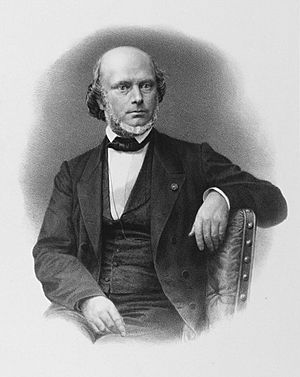Jean Louis Armand de Quatrefages de Bréau facts for kids
Quick facts for kids
Jean Louis Armand de Quatrefages de Bréau
|
|
|---|---|

Armand de Quatrefages
|
|
| Born | 10 February 1810 Berthézène, Valleraugue
|
| Died | 2 January 1892 (aged 81) Paris, France
|
| Nationality | French |
| Scientific career | |
| Fields | |
| Institutions | Lycée Napoléon French Academy of Sciences Museum National d'Histoire Naturelle Royal Society of London |
Jean Louis Armand de Quatrefages de Bréau (born February 10, 1810 – died January 12, 1892) was an important French biologist. He spent his life studying living things, from tiny worms to humans. He was especially interested in how different kinds of animals and people are related.
Contents
A Life of Learning and Discovery
Armand de Quatrefages was born in a small French village called Berthézène, which is part of Valleraugue. His father was a farmer. He first studied science and then medicine at the University of Strasbourg. He earned two degrees there, one in medicine and one in science.
Early Career and Moving to Paris
After finishing his studies, Quatrefages worked as a doctor for a short time in Toulouse. He also wrote articles for science magazines. However, he found it hard to do his research in the countryside. So, in 1839, he moved to Paris, a big city where he could do more scientific work. In Paris, he became friends with another famous scientist, Henri Milne-Edwards.
Becoming a Professor and Scientist
Quatrefages quickly became well-known in the scientific world. In 1850, he became a professor of natural history at the Lycée Napoléon, a famous school. Two years later, in 1852, he joined the French Academy of Sciences. This is a very important group of top scientists in France.
In 1855, he was given a special job at the Museum National d'Histoire Naturelle. He became the head of the department for studying humans and different human groups (anthropology and ethnography). He also became an honorary member of the Royal Society of London in 1879, which is a big honor from England. He continued his important work until he passed away in Paris.
His Scientific Approach
Quatrefages was very good at observing animals and collecting scientific information. He was also a talented writer, able to describe things clearly. He studied many different creatures, from simple worms to apes and humans. His detailed studies of how animals and humans are built (their anatomy) are still valuable today.
Views on Evolution
Quatrefages lived during a time when new ideas about how life changes over time were being discussed. He knew Charles Darwin, who developed the theory of natural selection.
Quatrefages and Darwin
Quatrefages and Darwin wrote letters to each other often, starting in 1859. Even though they had different ideas about evolution, they remained friendly. Quatrefages wrote a book called Charles Darwin et ses précurseurs francais (1870). In this book, he shared his thoughts and some criticisms about Darwin's ideas.
Darwin himself read the book and wrote to Quatrefages. He said that even though some of the criticisms were strong, they were always polite and fair. Darwin preferred to be criticized by Quatrefages than praised by others.
Debates in the French Academy
In 1870, Quatrefages and Henri Milne-Edwards suggested that Darwin should become a member of the French Academy of Sciences. However, some other scientists strongly disagreed. Because of this, Darwin did not get elected to the Academy at that time.
His Own Ideas on Evolution
In his book L'Espèce humaine (which means The Human Species, published in 1879), Quatrefages talked about evolution. He didn't fully agree with Darwin's idea that "natural selection" creates new species. Instead, he thought "natural elimination" was a better term. He believed that nature mostly removes weaker individuals, rather than actively creating new types of life.
Quatrefages also believed that all humans came from a single origin. This idea is called monogenism. He disagreed with the idea that different human groups came from many separate origins (called polygenism).
Key Scientific Works
Armand de Quatrefages wrote many scientific papers and books. His work covered a wide range of topics in zoology, which is the study of animals. He studied everything from small annelid worms to creatures similar to humans.
Some of his important works include:
- Considérations sur les caractères zoologiques des rongeurs (1840): This looked at the features of rodents.
- Recherches sur le système nerveux... des annélides (1844–50): This was a study of the nervous system and other parts of worms.
- Souvenirs d'un naturaliste (2 vols., 1854): This book shared his memories from scientific trips to places like the Atlantic and Mediterranean coasts, Italy, and Sicily.
- Histoire naturelle des Annelés marins et d'eau douce (2 vols., 1866): A detailed history of marine and freshwater worms.
- Charles Darwin et ses précurseurs francais (1870): His book discussing Darwin's theories.
- Crania Ethnica (jointly with Ernest Hamy, 1875–82): A very important work that studied human skulls from different groups around the world.
- L'Espèce humaine (1877) or The Human Species (1879): His book about the human species and his ideas on evolution.
- Histoire générale des races humaines (2 vols., 1886–89): A general history of human races.
- Les Pygmées (1887): A book about Pygmy people.

